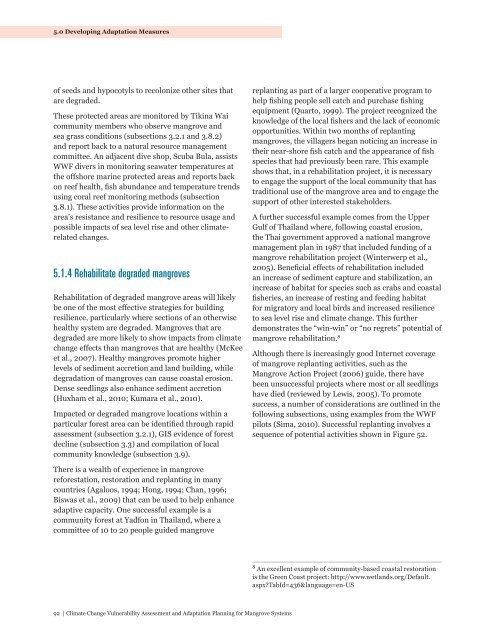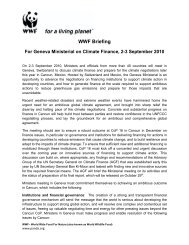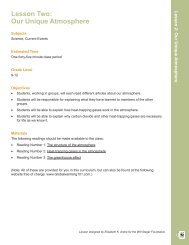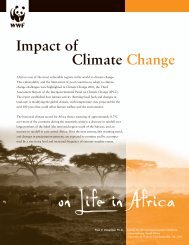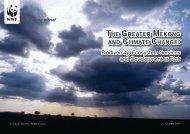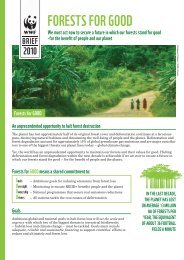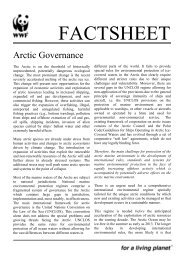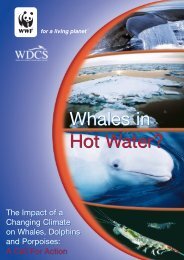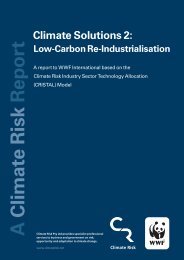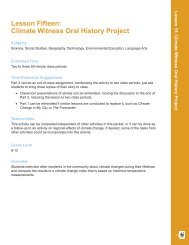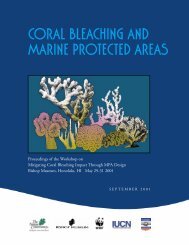5.0 Developing <strong>Adaptation</strong> Measuresof seeds <strong>and</strong> hypocotyls to recolonize other sites thatare degraded.These protected areas are monitored by Tikina Waicommunity members who observe mangrove <strong>and</strong>sea grass conditions (subsections 3.2.1 <strong>and</strong> 3.8.2)<strong>and</strong> report back to a natural resource managementcommittee. An adjacent dive shop, Scuba Bula, assistsWWF divers in monitoring seawater temperatures atthe offshore marine protected areas <strong>and</strong> reports backon reef health, fish abundance <strong>and</strong> temperature trendsusing coral reef monitoring methods (subsection3.8.1). These activities provide information on thearea’s resistance <strong>and</strong> resilience to resource usage <strong>and</strong>possible impacts of sea level rise <strong>and</strong> other climaterelatedchanges.5.1.4 Rehabilitate degraded mangrovesRehabilitation of degraded mangrove areas will likelybe one of the most effective strategies for buildingresilience, particularly where sections of an otherwisehealthy system are degraded. Mangroves that aredegraded are more likely to show impacts from climatechange effects than mangroves that are healthy (McKeeet al., 2007). Healthy mangroves promote higherlevels of sediment accretion <strong>and</strong> l<strong>and</strong> building, whiledegradation of mangroves can cause coastal erosion.Dense seedlings also enhance sediment accretion(Huxham et al., 2010; Kumara et al., 2010).Impacted or degraded mangrove locations within aparticular forest area can be identified through rapidassessment (subsection 3.2.1), GIS evidence of forestdecline (subsection 3.3) <strong>and</strong> compilation of localcommunity knowledge (subsection 3.9).replanting as part of a larger cooperative program tohelp fishing people sell catch <strong>and</strong> purchase fishingequipment (Quarto, 1999). The project recognized theknowledge of the local fishers <strong>and</strong> the lack of economicopportunities. Within two months of replantingmangroves, the villagers began noticing an increase intheir near-shore fish catch <strong>and</strong> the appearance of fishspecies that had previously been rare. This exampleshows that, in a rehabilitation project, it is necessaryto engage the support of the local community that hastraditional use of the mangrove area <strong>and</strong> to engage thesupport of other interested stakeholders.A further successful example comes from the UpperGulf of Thail<strong>and</strong> where, following coastal erosion,the Thai government approved a national mangrovemanagement plan in 1987 that included funding of amangrove rehabilitation project (Winterwerp et al.,2005). Beneficial effects of rehabilitation includedan increase of sediment capture <strong>and</strong> stabilization, anincrease of habitat for species such as crabs <strong>and</strong> coastalfisheries, an increase of resting <strong>and</strong> feeding habitatfor migratory <strong>and</strong> local birds <strong>and</strong> increased resilienceto sea level rise <strong>and</strong> climate change. This furtherdemonstrates the “win-win” or “no regrets” potential ofmangrove rehabilitation. 8Although there is increasingly good Internet coverageof mangrove replanting activities, such as theMangrove Action Project (2006) guide, there havebeen unsuccessful projects where most or all seedlingshave died (reviewed by Lewis, 2005). To promotesuccess, a number of considerations are outlined in thefollowing subsections, using examples from the WWFpilots (Sima, 2010). Successful replanting involves asequence of potential activities shown in Figure 52.There is a wealth of experience in mangrovereforestation, restoration <strong>and</strong> replanting in manycountries (Agaloos, 1994; Hong, 1994; Chan, 1996;Biswas et al., 2009) that can be used to help enhanceadaptive capacity. One successful example is acommunity forest at Yadfon in Thail<strong>and</strong>, where acommittee of 10 to 20 people guided mangrove8 An excellent example of community-based coastal restorationis the Green Coast project: http://www.wetl<strong>and</strong>s.org/Default.aspx?TabId=436&language=en-US92 | <strong>Climate</strong> <strong>Change</strong> <strong>Vulnerability</strong> <strong>Assessment</strong> <strong>and</strong> <strong>Adaptation</strong> <strong>Planning</strong> for Mangrove Systems
5.0 Developing <strong>Adaptation</strong> MeasuresNaturalregenerationSite preparationSpecies selectionDecide on approachDirect propaguleplantingPlantingseedlingsthey will have to tolerate a continually rising sea levelduring their lifetime. Therefore, the most resilientspecies to changing sea level will be those with toleranceof a wider elevation bracket, as identified in subsection3.4. In the WWF pilots, this was found to be Rhizophoraharissonii in Cameroon <strong>and</strong> Rhizophora stylosa in Fiji,as shown by the case studies in subsection 3.4.2.PlantingpropagulesPropagulecollectionNursery raising ofseedlingsMonitoringFigure 52. Flowchart of potential approaches tomangrove rehabilitation.5.1.4.1 Selection of “climate-smart”mangrove speciesWild seedlingcollectionPlantingseedlingsUnderst<strong>and</strong>ing the ecology of local species is animportant early step in successful mangrove restoration(Bosire et al., 2008), particularly in terms of choosingsites that have suitable hydrological regimes withrespect to the frequency <strong>and</strong> duration of tidal flooding(Figure 21; Mangrove Action Project, 2006; Bosire etal., 2008). Restoration also needs to consider changingfuture conditions of hydrology <strong>and</strong> mangrove habitats(Erwin, 2009) in planning areas for replanting <strong>and</strong>selecting species.The greatest sensitivity of mangroves to climate changeis to relative sea level rise that increases inundationperiods. Sea level rise is projected to increase over thelifetime of mangrove trees. Although they can migrate,5.1.4.2 Replanting practicesBefore rehabilitation, the cause of the originalmangrove decline or mortality should be identified<strong>and</strong> removed when possible (Lewis, 2005; Biswas etal., 2009). This can be informed by the results of themangrove condition assessment (subsection 3.2.1), GISanalysis (subsection 3.3) <strong>and</strong> community consultation(subsection 3.9). Impediments to mangroveestablishment, such as dead trees, debris, garbage <strong>and</strong>anything (even palm fronds) that may move aroundduring high tide, should be removed. This is becausesuch loose debris can move at high tide, especiallywith waves, <strong>and</strong> knock over planted seedlings. Localcommunities can assist in ongoing maintenance,including surveillance for other factors that mightprevent seedling growth, such as grazing or pig or dogdisturbance.As shown in Figure 52, there are three approachesto mangrove rehabilitation that can be used: naturalregeneration, propagule planting or seedling planting.a) Natural regeneration: This is a nonactiveapproach that protects <strong>and</strong> monitors the mangrovearea from the original stress <strong>and</strong> allows naturalregeneration to occur. This approach does notusually involve rates that would result in rapidregeneration of the area, <strong>and</strong> it does not allowspecies selection.b) Direct propagule planting: This approachinvolves active planting of mature mangrovepropagules in areas where they might grow. Thesurvival rate of seeds is usually much lower thanwith seedling planting.c) Seedling planting: This approach involves activeplanting of seedlings in areas where they might grow.The seedlings can be obtained from wild sourceselsewhere (wild seedling transplanting), or raised in amangrove nursery.<strong>Climate</strong> <strong>Change</strong> <strong>Vulnerability</strong> <strong>Assessment</strong> <strong>and</strong> <strong>Adaptation</strong> <strong>Planning</strong> for Mangrove Systems | 93
- Page 2 and 3:
© 2012 WWFISBN: 978-92-990069-0-0R
- Page 4 and 5:
© naturepl.com/Tim Laman/WWF
- Page 6:
Table of Contents, Figures8.0 Gloss
- Page 12 and 13:
Photo: Monifa Fiu
- Page 16 and 17:
1.0 Mangroves: Values, Status and T
- Page 20:
2.0 Planning a Vulnerability Assess
- Page 26 and 27:
3.0 Conducting a Vulnerability Asse
- Page 32:
3.0 Conducting a Vulnerability Asse
- Page 36 and 37:
3.0 Conducting a Vulnerability Asse
- Page 40 and 41:
3.0 Conducting a Vulnerability Asse
- Page 42:
3.0 Conducting a Vulnerability Asse
- Page 46 and 47:
3.0 Conducting a Vulnerability Asse
- Page 49:
3.0 Conducting a Vulnerability Asse
- Page 56 and 57: 3.0 Conducting a Vulnerability Asse
- Page 59: 3.0 Conducting a Vulnerability Asse
- Page 64: 3.0 Conducting a Vulnerability Asse
- Page 67 and 68: 3.0 Conducting a Vulnerability Asse
- Page 71: 3.0 Conducting a Vulnerability Asse
- Page 75 and 76: 3.0 Conducting a Vulnerability Asse
- Page 77: 3.0 Conducting a Vulnerability Asse
- Page 80 and 81: 3.0 Conducting a Vulnerability Asse
- Page 82 and 83: 3.0 Conducting a Vulnerability Asse
- Page 84 and 85: 3.0 Conducting a Vulnerability Asse
- Page 86 and 87: 3.0 Conducting a Vulnerability Asse
- Page 88 and 89: 3.0 Conducting a Vulnerability Asse
- Page 90 and 91: 3.0 Conducting a Vulnerability Asse
- Page 92 and 93: 4.0 Interpreting a Mangrove Vuneral
- Page 94 and 95: 4.0 Interpreting a Mangrove Vuneral
- Page 96 and 97: 4.0 Interpreting a Mangrove Vuneral
- Page 98: 5.0 Developing Adaptation MeasuresT
- Page 102 and 103: 5.0 Developing Adaptation Measures5
- Page 106 and 107: 5.0 Developing Adaptation Measures5
- Page 109 and 110: 5.0 Developing Adaptation MeasuresF
- Page 111 and 112: 5.0 Developing Adaptation MeasuresF
- Page 114 and 115: 5.0 Developing Adaptation Measures5
- Page 116 and 117: 6.0 ConclusionsClimate change, part
- Page 118 and 119: 7.0 ReferencesBosire, J. O., Dahdou
- Page 120 and 121: 7.0 ReferencesForbes, A. T., & Cyru
- Page 122 and 123: 7.0 ReferencesKovacs, J. M., Wang,
- Page 124 and 125: 7.0 ReferencesRogers, K., Saintilan
- Page 126 and 127: 8.0 GlossaryAbscission collar A reg
- Page 128 and 129: 8.0 GlossaryLiDAR Light Detection a
- Page 130 and 131: Photo: Rob Anders
- Page 132 and 133: Appendix: Data Sheets120 | Climate
- Page 134 and 135: Appendix: Data Sheets122 | Climate
- Page 136 and 137: Appendix: Data SheetsData sheet for
- Page 138 and 139: Appendix: Data Sheets126 | Climate
- Page 140: Appendix: Data Sheets128 | Climate


